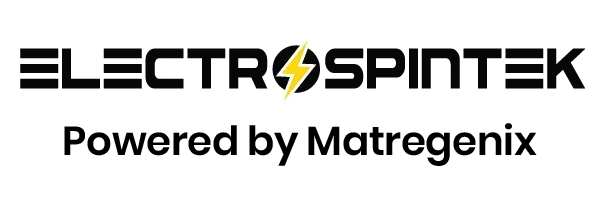In the rapidly evolving world of nanotechnology, innovation never rests. Among the trailblazing advancements in recent years, needleless electrospinning stands out as a true game-changer. While traditional electrospinning has long been revered for its ability to create fine, consistent nanofibers, its limitations in scalability and maintenance have opened the door for more efficient methods.
Enter needleless electrospinning a novel, scalable, and efficient approach that’s transforming how nanofibers are produced at an industrial scale. At Electrospintek, we’re harnessing the potential of this groundbreaking method to redefine electrospinning technology.
What Is Needleless Electrospinning?
Needleless electrospinning, also known as needle-free electrospinning, is an advanced technique used for fabricating nanofibers without the conventional needle-based nozzles. Instead of pushing polymer solutions through individual needles, this technique utilizes a rotating cylinder, wire, disc, or other emitter shapes to spontaneously generate multiple jets from a free liquid surface under a high-voltage electric field.
This results in a more uniform and prolific nanofiber output, overcoming the bottlenecks of single-needle systems, such as clogging, limited throughput, and high maintenance.
Key Advantages of Needleless Electrospinning
1. Enhanced Scalability and Mass Production
One of the most significant advantages of needleless electrospinning is its exceptional scalability. Traditional systems with one or several needles struggle with mass production. The scalable nanofiber manufacturing capability of needleless systems makes them ideal for commercial and industrial applications.
At Electrospintek, we leverage this feature to produce nanofiber mats across large surface areas, perfect for use in air filtration, biomedical scaffolds, textiles, and beyond.
Benefits:
- Continuous production of nanofibers
- High throughput rates
- Suitable for roll-to-roll manufacturing systems
2. Reduced Maintenance and Downtime
Clogging is a notorious issue in needle-based electrospinning. Polymer residues can block the needle, disrupting production and requiring manual cleaning a laborious and time-consuming task.
Needleless systems eliminate this concern entirely. With needle-free electrospinning systems, there’s no narrow conduit to get blocked, drastically reducing downtime and boosting operational efficiency.
What This Means for Manufacturers:
- Fewer interruptions in production
- Longer equipment lifespan
- Reduced labor costs
3. Uniform and Consistent Nanofiber Quality
Uniformity is paramount in nanofiber production methods, especially in applications like drug delivery or energy storage, where fiber consistency directly affects performance.
Thanks to multiple jet formations and a stable electrostatic field, needleless electrospinning creates fibers with consistent morphology and diameter. The resulting nanofibers are smooth, defect-free, and reliable making them a superior choice for advanced nanomaterial fabrication.
4. Energy Efficiency and Sustainability
Needleless systems typically consume less energy per unit of output compared to their needle-based counterparts. Fewer moving parts and efficient jet formation mean that more nanofibers are produced using the same or even less power.
At Electrospintek, we prioritize sustainability in our production lines. Adopting needleless electrospinning helps us reduce waste, energy consumption, and carbon footprint, aligning with eco-conscious manufacturing goals.
5. Versatile Material Compatibility
From synthetic polymers like polycaprolactone (PCL) to biopolymers such as chitosan, needleless electrospinning accommodates a wide array of materials. This versatility opens the door to innovative applications across industries including:
- Biomedical engineering
- Environmental remediation
- Energy storage
- Protective clothing
Whether you’re creating breathable membranes or functional nanocomposites, this method enhances the adaptability of your manufacturing setup.
6. Lower Operational Costs
When you factor in fewer maintenance needs, faster production rates, and reduced energy bills, the cost-effectiveness of needleless electrospinning becomes crystal clear. For companies like Electrospintek, this translates to competitive pricing, higher profit margins, and broader market reach.
Over time, the reduced need for skilled technicians to unclog or replace needles adds another layer of savings without compromising product quality.
Applications Benefiting from Needleless Electrospinning
Here’s a quick look at industries thriving with this technology:
- Medical Textiles: Creating wound dressings, tissue scaffolds, and drug carriers with fine-tuned fiber diameter.
- Filtration Systems: Producing nanofiber layers for high-efficiency air, water, and oil filtration.
- Battery & Fuel Cells: Fabricating separators and electrode materials for next-gen energy storage devices.
- Protective Clothing: Enhancing durability, breathability, and barrier protection in fabrics.
The high throughput of needleless electrospinning makes all these applications more economically feasible and scalable than ever before.
How Electrospintek Is Leading the Charge
At Electrospintek, we don’t just adopt trends we set them. Our in-house engineered needle-free electrospinning systems are designed with precision, scalability, and automation in mind. We focus on integrating smart control systems, real-time monitoring, and user-friendly interfaces into our equipment to make nanofiber manufacturing seamless and intelligent.
Whether you’re scaling up your R&D lab or transitioning to full industrial production, we have the systems and expertise to support your goals.
Overcoming Challenges
Of course, no method is without its hurdles. Controlling fiber orientation and precisely targeting fiber deposition can be more challenging in needleless setups due to the chaotic nature of multiple jets. But with optimized system designs and environmental controls, these issues are being rapidly addressed.
Electrospintek continues to push boundaries through:
- Advanced emitter designs
- Process parameter optimization
- Tailored environmental controls
The Future of Needleless Electrospinning
The future looks bright for needleless electrospinning. As industries demand faster, greener, and more versatile nanofiber solutions, this method offers the perfect blend of innovation and practicality.
New developments on the horizon include:
- AI-driven real-time quality monitoring
- Hybrid systems combining needle and needleless methods
- Portable and modular spinning units
With the increasing need for advanced nanomaterial fabrication, this technology will play a central role in shaping materials of tomorrow.
Conclusion
In the world of nanotechnology, precision, scalability, and sustainability are non-negotiables. Needleless electrospinning hits all these marks offering a powerful, efficient, and innovative method for nanofiber production. Whether you’re a researcher, manufacturer, or industry leader, this technology holds the potential to revolutionize how you approach material science.
At Electrospintek, we’re proud to be at the forefront of this transformation. Our dedication to electrospinning technology ensures that your nanofiber journey whether experimental or industrial meets the demands of today and the promise of tomorrow.
